The Egyptian Papyrus “Book”
Once a papyrus sheet was formed it was joined together with other sheets to form long rolls. The papyrus roll format dates back to ~3,000 BCE and there is little evidence individual sheets were ever used alone. Smaller papyrus documents were either from halved or quartered rolls cut to certain lengths.
To make the roll, individual sheets were overlapped slightly; normally the sheet on the right overlapped the sheet on the left by 1-2 cm. The overlap was pasted, pressed and possibly burnished. Recent analysis has identified starch paste in the joins of several ancient papyri. Twenty sheets was the standard roll.
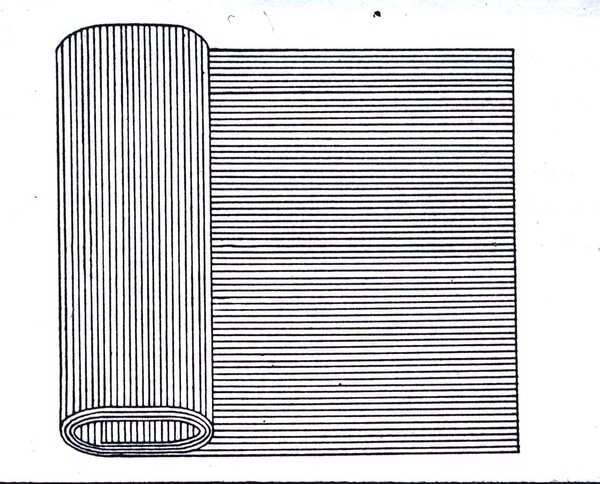
The completed roll or book was then rolled with the horizontal fibers on the inside and the vertical ones on the outside. If rolled in the opposite direction (vertical fibers inside) the fibers would have been crushed. The roll format explains why a laminate structure of perpendicular fibers was necessary. The rolls were stored either upright in vertical containers or in chests.
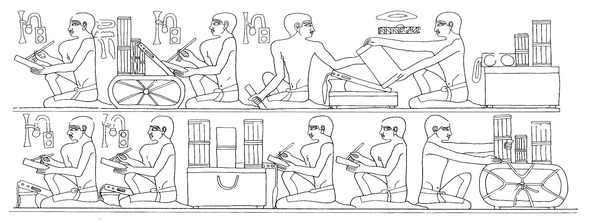
The height of the rolls varied in different periods. From ~2700-2200 BCE the maximum height was between ~8 and 9 ½”; while in the New Kingdom period ~1500-1100 BCE the average height was ~16″.
All types of recorded information were written on papyrus rolls or sections of a roll including legal, medical, administrative, mathematical and personal documents. In the 18th dynasty (~1400 BCE) funerary texts began being copied onto papyri rolls and placed in wealthy burials; these became known as Books of the Dead. These books usually read right to left and are unrolled from right to left.
The Book of the Dead of the Goldworker of Amun, Sebekmose a New Kingdom papyrus dating 1430-1400 measures 14″ in height and consists of 18 joined full sheets (each~16″ in width) and one partial sheet. The joins are easily identified in transmitted light as darker vertical lines due to the added opacity caused by the overlap.
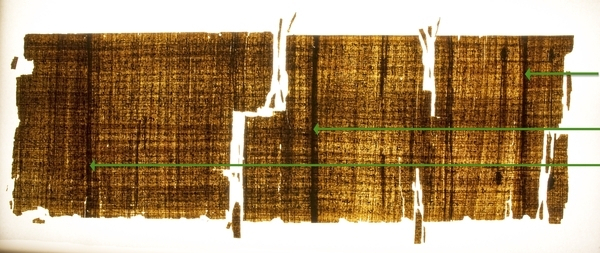
One of the most unusual features of this Book of the Dead is that it is written on both sides of the papyrus. Normally scribes would avoid the vertical fiber side (verso) because it formed the outside of the roll and received the most wear, while the horizontal fiber side (called the recto) was better protected being on the inside. As expected the spells and chants begin on the recto side. They are written in vertical columns in hieroglyphs and read correctly from right to left. The final spell, on the far left of the roll is completed just past the join of the 18th and 19th sheet (the area represented by the black parallel lines in this image).
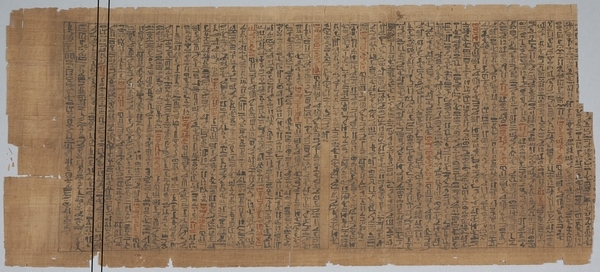
Note the last hieroglyph does not reach the bottom of the last column. The scribe has completed his work and does not need the extra 1 ½ sheets, thus explaining why there are 18 ½, rather than 20, sheets in this roll.
For whatever reason, and we are not sure why, after cutting off the rest of the roll the same scribe then flipped the roll horizontally and began writing on the verso in hieratic, a cursive form of hieroglyphs.
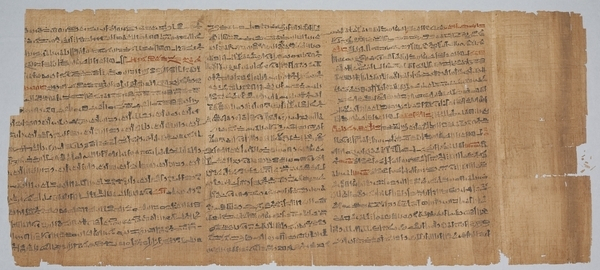
Note he begin the script just to the left of the last join which appears slightly lighter in color on the verso. The hieratic spells cover approximately 2/3 of the verso of the papyrus.
Treatment and analysis of this rare Book of the Dead is ongoing and as scientists, conservators, curators and modern papyrus makers continue their research the secrets of ancient Egyptian papyrus will also continue to unfold.
—-
This post is part of a series by Conservators and Curators on papyrus and in particular the Book of the Dead of the Goldworker of Amun, Sebekmose, a 24 foot long papyrus in the Brooklyn Museum’s collection. This unique papyrus currently in 8 large sections has never been exhibited due to condition. Thanks to a generous grant from the Leon Levy Foundation, the entire papyrus is now undergoing conservation treatment. The conservation work is expected to last until fall 2011 when all 8 sections will be exhibited together for the first time in the Mummy Chamber. As each section is conserved, it will join those already on exhibition until eventually the public will see the Book of the Dead in its entirety.

Toni Owen is Senior Conservator at the Brooklyn Museum. She joined the staff in 1986 to help plan the Museum’s paper conservation laboratory. Toni received her Master’s Degree and Certificate of Advanced Study in Conservation from the State University of New York, Cooperstown, New York. Prior to the Brooklyn Museum Toni was a Mellon Fellow at the Metropolitan Museum of Art and from 1977 until 1985 she was head of Paper Conservation at the Hirshhorn Museum and Sculpture Garden, Smithsonian Institution.
